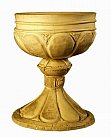Chalice of Ulrich

A chalice kept in the church treasure of St. Ulrich and St. Afra in Augsburg, which the parish still uses today, refers in its designation to Saint Ulrich. He was a bishop of Augsburg for 50 years, but was admired mainly because of his role in the battle on the Lechfeld, which averted the threat of military aggression by the Hungarians in 955. He died in 973 and was buried in St. Ulrich und St. Afra. During a church fire in 1183 his remains were saved and a Cuppa and a jewel-decorated bead moulding were taken from his grave and set in a new chalice. It is believed that this occurred in 1187, the year the 6th church was consecrated and the first tansfer of Saint Ulrich’s human remains completed. The chalice is divided at its foot and at the Cuppa by eight relief tongues. These are alternately gilded, chased and punched. While fabulous dragon-like creatures can be seen on the Cuppa, the foot shows Ulrich, his parents and Afra. The history of the chalice seems to come to an end in the 19th century. It was handed over to the police authorities for melting after the secularization, but Bishop Clemens Wenzeslaus von Augsburg rescued it and in 1812 bequeathed it to the Generalvikariat. Through the efforts of Pastor P. Benedict Abbt, the chalice was returned to the parish on 21 March 1827. The plaster included in the collection in Halle must have been poured after this and before 1954/55, the year the chalice was restored by Michael Wilm (Munich). With this restoration, modifications were made, which the cast doesn’t show. Therefore, the cast returns the chalice to a condition in which the original no longer appears.




